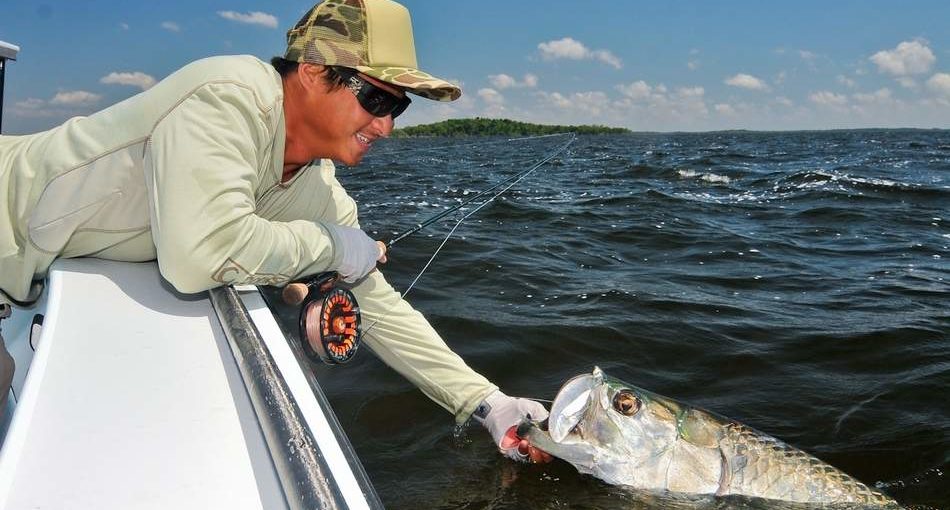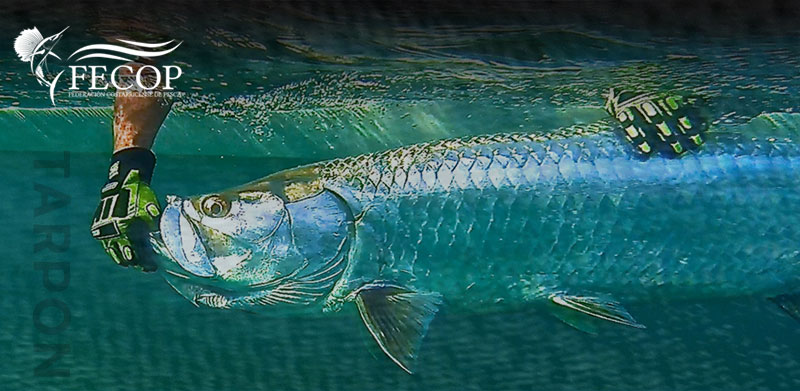New Pacific Tarpon Study Needs Your Help
Atlantic Tarpon in the Eastern Pacific 80 years after passing through the Panama Canal
The opening of the Panama Canal 100 years ago allowed marine organisms that can cope with passage through 65 km of fresh water to pass between the Atlantic and Pacific oceans. The Atlantic Tarpon, Megalops atlanticus, is one species that has swum through the canal to the Tropical Eastern Pacific (TEP).
Tarpon were first seen in the Pacific locks of the 25 years after the opening of the canal, and large adults have subsequently been observed in Panama Bay over many years. Now Tarpon’s TEP geographic range now extends along 2600 km of the coastline (Guatemala, Nicaragua, Costa Rica, Panama to the Colombia/Ecuador border). Small juveniles have been found throughout the main part of its TEP range, up to 700 km from the Panama Canal. As such juveniles are sedentary and have never been seen inside the Panama Canal, they most likely were spawned in the TEP. At present, nothing is known about the basic ecology of Tarpon in the TEP and possible effects it might have on native ecosystems there.
Tarpon biology in its native range
The native range of M. atlanticusincludes warm waters of both the Eastern and Western sides of the Atlantic Ocean. The Tarpon is a large [to 2.5 meters total length, 161 kg], highly migratory, predatory pelagic fish with a long life span (up to 78 years). It matures at a large size and considerable age: minimum ~105 cm for males and ~142cm for females, and 7–10 years respectively, in the US(at a smaller size inCosta Rica and Brazil). Tarpon migrate, en masse, from near-shore waters to the edge of the continental shelf to spawn. Eggs are pelagic and larvae develop in offshore waters for 20-50 days, before recruiting to coastal lagoons and estuaries, where they spend the next 0.5–2 years. Between that stage and when they mature Tarpon inhabit coastal and brackish waters and lateralso use freshwater habitats. Although a few spend time in freshwater or hypersaline water most small juveniles live in brackish,stagnant, hypoxic lagoons. They can readily survive in such habitatby air-breathing, a capacity retained by adults. “Rolling” at the surface to breathe and leaping from the water facilitates detection of Tarpon.History of information on the occurrence of Tarpon in the TEP. For the first time in 1937, the presence of Tarpon 1–2m long in the Miraflores and Gatun lakes of the Panama Canal was documented. In the early 1970s catches of adult specimens (1–1.5m) in the Miraflores locks were also reported with sport-fishers in the Bay of Panama often reporting catching Tarpon.In the 1980sTarpon were caught at Coiba Island, in the Gulf of Chiriquí and andin a river draining into the eastern side of Panama Bay 300km from the Panama Canal. In the late 1980s fishers recorded juveniles as small as ~ 0.9kg (~ 50cm)in a permanent lagoon at Punta Chame. In the early 2000s Tarpon in the TEP were distributed from southern Costa Rica to northern Colombia. In 2018 Tarpon captures were reported in El Salvador,Guatemala(from 2013), and at the Colombia/Ecuador border, ~800 km from Panama Bay. Thus Tarpon currently ranges across~ 2600 km of the coast of six countries between Guatemala and the Colombia/Ecuador border, and has apparently expanded over the past 20 years
Juvenile Tarpon in the TEP. Juvenile Tarpon have been found at various sites in central and southern Costa Rica, the Gulf of Panama, and Colombia. Small juveniles in a brackish lagoon of Punta Chame, 40 km from the Pacific entrance to the Panama Canalwere reported in the 1980s. Such lagoons represent the type of habitat to look for small Tarpon in the TEP
In the Panama area of the TEP the very large tidal range means that most mangroves drain completely at low tide. Because of this draining successful reproduction of Tarpon in the TEP may be limited by the lack of suitable habitat (hypoxic, “safe-harbor” tidal lagoons) for young juveniles after settlement at the end of the pelagic larval stage.
[su_quote]Is Tarpon likely to become invasive and have adverse effects on native species in the TEP? [/su_quote]
Nothing currently is known about the feeding ecology of Tarpon in the TEP, a first step towards assessing what impact it might have. The only biological information available on Tarpon in the TEP that bears on the question of its actual impact is that relating to its restricted geographic range, the low abundance of juveniles, and apparent low abundance of adults. That combination points to a low current impact.Eighty years after it first entered the TEP, and with the continued ability to do so since that event, Tarpon does not appear to have a substantial population in that region. While 80 years may seem a long time, that represents only 6–7 generations for Tarpon.
Low current abundance of Tarpon may in part reflect a long lag-period of expansion for a slow-growing, late-maturing, long-lived organism like Tarpon. While Tarpon may have the potential to become invasive by having adverse impacts in the TEP its population status in its native range indicates that is not particularly likely. Fishing and habitat degradation in its native range represent major threats for this species that have put its population at risk there. A population in the TEP will face the same threats and there is no reason to think it will be more successful at coping with them than the population in the Atlantic. Conclusions and research needed.
Although it is clear that Tarpon can survive in and, almost certainly, is breeding to some extent in the TEP its ecological impact there is unknown. Research on the feeding ecology, growth and reproductive status (gonadal activity) of this species in the TEP would help clarify what impact it might be having and how successful it is at exploiting local food resources.If successful reproduction of Tarpon in the TEP maybe limited by the lack of suitable habitat (hypoxic, “safe-harbor” tidallagoons) for young juveniles then its population may never expand much beyond its present level. Assessment of the availability of such habitats, of physical conditions in them and of their predatory fish faunas in both microtidal (Mexico) and macrotidal parts of the TEP, would be useful in that context.
The recent expansion of the Panama Canal seems likely to have effects on the transfer of alien species between TEP and Western Atlantic. This likely will enhance the exchange of euryhaline marine species between both sides of the Isthmus. More and larger locks and increased shipping movements through the canal inevitably will facilitate the transit of more Tarpon. Monitoring of Tarpon catches on the Pacific coast of Panama could indicate the extent to which that is occurring.An increasing recreational fishing sector in Colombia, Panama, Costa Rica and potentially, elsewhere in the TEP, can benefit from the existence of Tarpon in the region (e.g. Tarpon fishing in theBayano River of Pacific Panama).
Much of the information presented here has come from local sport fishing operators in those countries. Future research on this species should involve partnerships with this sector in order to understand more comprehensively the implications of the presence of a population of Tarpon that is slowly expanding in the TEP.Read the complete article here:
Have you seen Tarpon (juveniles or adults) in the Eastern Pacific?
Please register its location as precisely as possible, and provide a photograph that will clearly indicate the size of the fish. Also a few dried scales from its back,and/or a small piece of fin (in alcohol) would be most useful for research:
Gustavo Castellanos-Galindo: gustavoa80″@”yahoo.com
D.Ross Robertson: drr”@”stri.org
PDF VERSION
[pdf-embedder url=”https://fishcostarica.org/wp-content/uploads/2019/05/Atlantic-Tarpon-in-the-Tropical-Eastern-Pacific_synthesis_revised_Final.pdf” title=”Atlantic Tarpon in the Tropical Eastern Pacific_synthesis_revised_Final”]






















